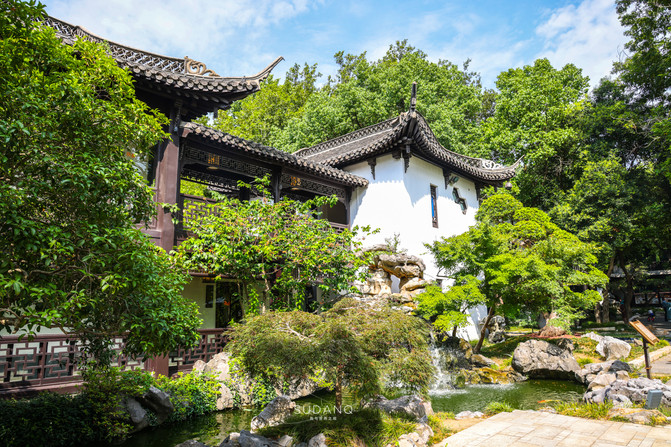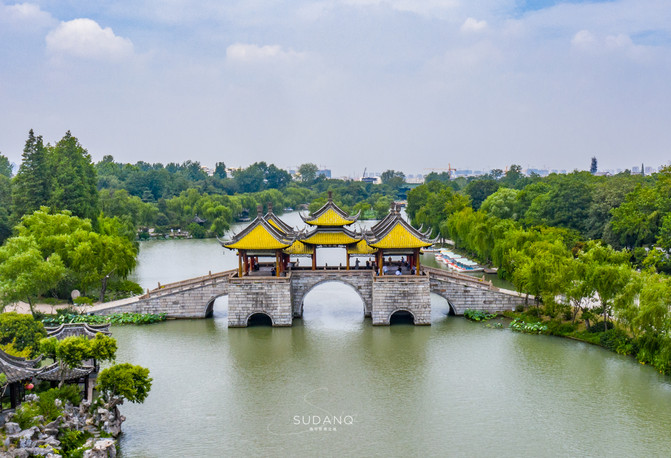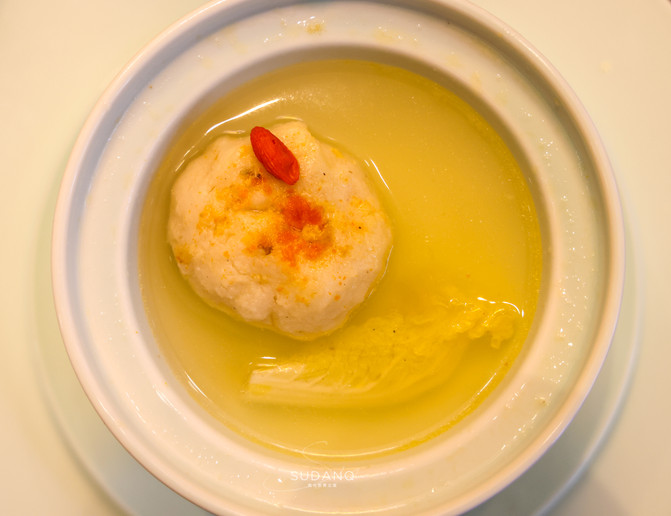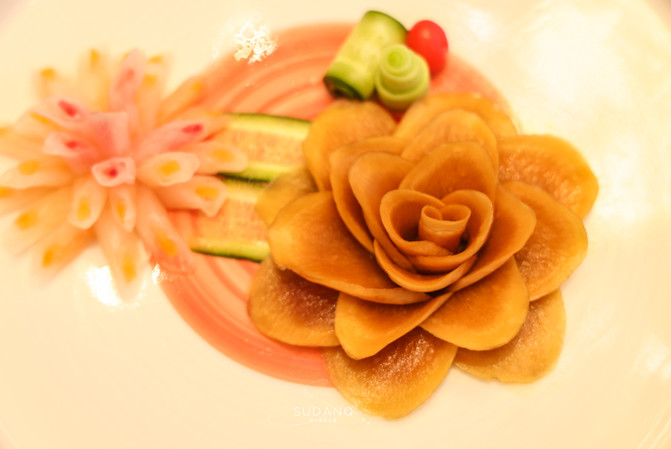5-Day 4-Night Yangzhou Summer Vacation: Be a Yangzhou native and live a slow life
Coincidentally, I set off from Wuhan to Yangzhou, and this journey deepened the poet's artistic conception: 'The old man bid farewell to the Yellow Crane Tower in the west'. Although it's not March, the Yangzhou summer in July also has its own charm and beauty.

Yangzhou, formerly known as "Guangling", is one of the ancient cities in China with relatively well preserved historical features. It is a world heritage city and the cultural capital of East Asia.

It is located at the intersection of the Yangtze River and the Beijing Hangzhou Grand Canal, known as the geometric center of Jiangsu Province's land area, and is known as the "famous capital on the left bank of the Huai River and the best place in the west of the Zhu River". It is also known as the "first city of China's Grand Canal" and is known as the "Yang Yi Er" and "Moon City".

Entering Yangzhou, one cannot help but discover the uniqueness of Jiangnan's scenery. This is a city where small things reveal big things, an ancient city with slow and distinctive sounds, and also a capital of world cuisine. It has a favorable natural environment, distinct four seasons, a warm climate, and a well-developed tourism culture. The phrase 'fireworks in Yangzhou in March' spans thousands of years.

Unlike other city tours, entering Yangzhou requires adjusting to a slower pace. Yangzhou is slow, slow is the accumulation of history, slow is the accumulation of culture, slow is the attitude towards life. Only by being slow can one understand how much stunning time time time has given to Yangzhou.
01 Slow Day in Yangzhou, Starting from Morning Tea

In the world of morning tea culture, Yangzhou morning tea also has a strong and colorful mark.

In the morning, you'll be covered in water, and in the evening, you'll be covered in water. These are the two great pleasures of Yangzhou's journey, and also a ritual for Yangzhou people: getting up early to have morning tea and taking a bath at night. Without these two, the small bridge flowing water, blue bricks and black tiles, would lose some of their essence.

Tasting Yangzhou morning tea is not only a way of eating, but also about the gentle and tender feeling. It must be slow and leisurely, and one can feel the gentleness and elegance of Jiangnan's habits from the taste.

Here, people can take seemingly simple daily meals to the extreme of knife cutting and cooking. What you bite down with one bite is the accumulated ingenuity.

There are countless tea houses in Yangzhou, big and small, with both emerging and classic ones. But if you want to experience Yangzhou's garden culture and historical atmosphere, you have to go to a tea house that can withstand the test of time.
Recommended tea houses: Quyuan, Yechun

The Fun Garden by the Slender West Lake is a tea house that I must visit every time I visit Yangzhou. Quyuan, also known as Huangyuan, was originally a separate business built by the salt merchants Huang Luxian and his brothers in the Qing Dynasty. In the 27th year of the Qianlong reign (1762), during his southern tour of Yangzhou and his visit to Shouxi Lake, Emperor Qianlong bestowed the name "Quyuan" upon it.

This is a garden style tea house, with two major scenic spots: "Water Cloud Victory Concept" and "Four Bridges Smoke and Rain". There are also pavilions, rockeries, small bridges, flowing water, and secluded paths that offer a panoramic view of the beauty of the garden. Eating morning tea here is a beautiful enjoyment, as if the beauty of all things is condensed in a fun garden.




Holding a cup of clear tea in hand, a few close friends gather around the table, watching the swaying willows by the river, listening to the melodious tunes of Yangzhou, up close to the slim West Lake, overlooking the scenery of the ancient city, eating hot dry silk, shaomai, crab roe soup buns, three ding buns, thousand layer oil cake, silver silk noodles without haste or delay

Since I went to Yangzhou, I have always had a slight preference for morning tea over other delicacies.

Like Quyuan, Yechun Tea House has a history of over a hundred years and was also visited by Emperor Qianlong.
There are many branches of Yechun Tea House. Coincidentally, there is also a shop by the banks of Shouxi Lake (Hongqiao Square Store), which, although not as integrated as Quyuan, has its own tranquility.

Yechun morning tea is mainly composed of Huaiyang snacks and snacks, including big boiled dried silk, five diced buns, crab roe buns, thousand layer cake, roasted wheat, Steamed dumplings, etc.
This is common in tea houses of all sizes in Yangzhou, but each chef has their own unique skills, and the same tea has different ways of serving.

The most famous one is still jade burning, known as the "unparalleled twin pride", which has a unique flavor.
Must order for morning tea: blanched silk, jadeite shaomai, crab roe buns, three ding buns, five ding buns, silver silk noodles, shrimp seed dumpling noodles, etc.

The prosperity of gardens is unparalleled in the world
Opening the history of Yangzhou, a sense of prosperity fills the air.
Yangzhou, known for its wealth, is not only materially advanced, but also rich in spiritual culture. Of course, this is also due to the 'wealth struggle' among salt merchants. Showcasing financial and material resources through the construction of gardens.

Yangzhou gardens have become famous throughout the world, not only becoming a place that literati and scholars aspire to, but also a popular tourist destination for ancient emperors. Kangxi and Qianlong would always come to Yangzhou to visit during their travels to Jiangnan.

Slender West Lake: the pinnacle of gardens, unparalleled in the world
Strolling through Yangzhou gardens, Shouxi Lake always ranks first. The various' wealth struggles' of Yangzhou salt merchants in the past can be seen on both sides of the Slender West Lake today.
The Shouxi Lake had already formed a basic pattern during the Kangxi and Qianlong periods of the Qing Dynasty, and was known as the "peak of gardens, unparalleled in the world".

According to the "Yangzhou Painting Boat Record", there are twenty-four scenic spots in Shouxi Lake. "The two embankments of flowers and willows are all along the water, and the towers and pavilions stretch all the way to the mountains." "More than ten gardens and pavilions merge into one, and the momentum runs through them all.





Today's scenery of Shouxi Lake includes the Grand Hongqiao Bridge, Changdi Chunliu, Wuting Bridge, Xiaojin Mountain, White Pagoda, Wangchun Tower, Xichun Terrace, and more. In 2014, Shouxi Lake, as one of the heritage sites of the Grand Canal of China, was listed on the World Cultural Heritage List.

He Garden: The First Garden of the Late Qing Dynasty
As a model of Yangzhou style gardens, He Garden is one of the gardens that cannot be missed during the trip to Yangzhou.

Heyuan, also known as "Jixiao Mountain Villa", is a Chinese classical garden architecture that was first built in the mid Qing Dynasty. It is also a representative work of Yangzhou gardens in the late Qing Dynasty and is known as the "first garden of the late Qing Dynasty".

He Yuan was built by He Zhizhen during the reign of Emperor Guangxu of the Qing Dynasty, and the Pianshi Mountain House is a masterpiece created by Master Shi Tao. The main attractions include the Fudao Corridor, the Horse Riding Building, etc. The entire park is divided into four parts: the East Garden, the West Garden, the Garden Residence Courtyard, and the Pianshi Mountain House.

The biggest feature of this garden is the full utilization of the functions and charm of the corridor architecture. The 1500 meter long compound corridor is a rare landscape in Chinese gardens.

It splits left and right, connects high and low, carries mountains and water, and enters the house, forming a comprehensive three-dimensional landscape and all-weather tourist space, showcasing the beauty of Chinese garden art's circular changes and the beauty of connectivity. It is the earliest prototype of an overpass in China.

Individual Garden: One of the Four Famous Gardens in China
Yangzhou people not only know how to do business, but also have a fanatical pursuit of beauty. Today, the beauty of Yangzhou's gardens and the delicacy of its cuisine are all thanks to these salt merchants. Of course, a garden is no exception.

As one of the four famous gardens in China, Yiyuan was a private garden in the Qing Dynasty, owned by a very wealthy salt merchant in Yangzhou at that time.

The beauty of the garden is known for the widespread planting of green bamboo, and for the four seasons of rockery in spring, summer, autumn, and winter. They are respectively Spring Mountain, Summer Mountain, Autumn Mountain, and Winter Mountain, expressing the poetic and picturesque meaning of "spring scenery is beautiful and smiling, summer mountain is lush and dripping, autumn mountain is clear and makeup like, winter scenery is bleak and sleeping", praised by the garden master Mr. Chen Congzhou as a "unique example in China".


Yangzhou Guesthouse: The 'Ceiling' of Garden Hotels
The Yangzhou Guesthouse is actually a place for dining and accommodation, but due to its exquisite garden design, I can't help but classify it as a "garden" (including Quyuan and Yechun).

Although the layout and design of hotel rooms are very simple, the elegant and tasteful temperament makes people feel very comfortable. Of course, the main reason for staying in a guesthouse is still its classical architectural style.





The pavilions and towers in the park are lush with flowers and trees, winding with flowing water, and facing the Xu Garden, Siqiao Yanyu Tower, and Changdi Chunliu across the water in Shouxi Lake Park.

Waking up early in the morning, standing by the window and looking out, the blue tiled roof, distant trees, and Buddhist pagodas formed a beautiful scenery, and the joy of harvest was beyond words. I can't help but envy the people of Yangzhou: they have exquisite cuisine, exquisite scenery, and exquisite life.
03 Huaiyang Cuisine: the real protagonist of Yangpai's food
Some people say that Yangzhou is a garden city that can be tasted with food. In the past, salt merchants in Yangzhou were not only extremely dedicated to garden design, but also passionate about food.

Huaiyang Cuisine is the classic representative of Yangpai food, whose characteristics lie in taste and its art lies in type. Eating Huaiyang Cuisine in Yangzhou is both delicious and scenic.

It is light and elegant, full of literati temperament, and its arrangement is full of the blank space art of Chinese painting; It emphasizes the original flavor and delicate knife technique, exuding the spirit of "never tired of fine food and never tired of fine dishes" everywhere; It has intricate and delicate pyrotechnic techniques, yet its taste and form are light and indifferent. With the most refined scholarly craftsmanship, it creates the most elegant human fireworks.

In short, Huaiyang Cuisine is clear and fresh, fresh and light. The signature dishes include lion's head, salted goose, Wensi tofu, Gaoyou double yolk eggs, etc. Recommended restaurants: Shanying Villa, Yangzhou Banquet, Canal Banquet, Yechun, 7 Eats 8 Bars, Wanfeng Hotel.

Shanying Villa: Garden Restaurant in Shouxi Lake
The dining villa located in the Shouxi Lake scenic area left a deep impression on me. It's really a poetic experience to enjoy the delicious Huaiyang Cuisine here.

Shanying Villa is located near the east gate of Shouxi Lake, at the southwest corner of Wan Garden. The appearance is modeled after the residential villa of Yan Ying, which was inherited by a renowned horticulturist in Yangzhou in the early years of the Republic of China. The exterior adopts the traditional classical garden architectural style of Yangzhou. Here, you can not only eat authentic Huaiyang Cuisine, but also experience authentic characteristic morning tea, featuring "Yangzhou Brand".
Yangzhou Banquet: The filming location of "Twelve Sharp Flavors"
Yangzhou Banquet is one of the high-end restaurants that eat authentic Huaiyang Cuisine, and it is also the shooting place of Twelve Frontier Tastes. The elegant environment of Chinese style reflects the ancient beauty of a city.

Yangzhou Feast not only has traditional Huaiyang Cuisine snacks, but also exquisite Huaiyang cuisine, which integrates freshness, neutralization, fashion and health care. It has classic Gaoyou double yellow duck eggs, steamed green crab with scallion meat cake, baked yellow croaker in casserole, and Gaoyou Wang tofu with oil residue. It can be said that it is a Jiangnan style feast that restores the local flavor of Mr. Wang Zengqi's "Human Vegetation".

Canal Banquet: Internet famous restaurants around museums
The canal banquet beside the China Grand Canal Museum is also a very popular Huaiyang Cuisine cuisine restaurant in Yangzhou: visiting the museum to eat Huaiyang Cuisine has become a daily part of my trip to Yangzhou.

The Grand Canal between Beijing and Hangzhou is world-renowned. It starts from Yuhang (now Hangzhou) in the south and ends at Zhuojun (now Beijing) in the north, with a total length of about 1797 kilometers. The ancient Grand Canal not only connects many cities together, but also blends the flavors of the north and south. This is vividly reflected in the China Grand Canal Museum.

When I came out of the museum and went to the Canal Banquet for lunch, the ancient culture of the canal instantly became three-dimensional, vivid, and flavorful.


The cuisine of the canal banquet includes Huaiyang Cuisine cuisine, Beijing cuisine, Shandong scenery... You can't miss the canal banquet when you feel the history and culture of the Grand Canal in the cuisine.

Yechun: both tea house and Huaiyang Cuisine restaurant
During my 5-day and 4-night trip to Yangzhou, I chose to have breakfast and dinner in Yechun for one of the days. Not only is it close to my hotel (Huajiantang), but also the Huaiyang Cuisine here is worth my decision.
Recommended dishes: four pieces of fragrant geese, three fresh Lo mein, fried buns, fried chrysanthemum heads, squirrel mandarin fish, Loong Boat catfish, leek flavored soft pouches, lily, dried tangerine peel, duck worms.

But what's even more exciting is that you can taste delicious food and listen to music at the same time, it's truly a surreal feeling of time and space interweaving, wonderful to the extreme.

Seven to eight: New Huaiyang Cuisine Cuisine
Located on the bank of the Slender West Lake, the 7-bar and 8-bar Sunshine Restaurant is a famous restaurant in Yangzhou. It is a new Huaiyang Cuisine cuisine restaurant. Here, both the original flavor of Huaiyang Cuisine and the innovation of fusion cuisine are available.

Wanfeng Hotel
During my recent trip to Yangzhou, I ate a lot of restaurants specializing in Huaiyang Cuisine. Each one left an unforgettable impression on me, making it difficult to distinguish between the best and the worst. Wanfeng Hotel, located at the south gate of Weilan Building, 102 Shugang West Road, Hanjiang District, is also a good Huaiyang Cuisine Restaurant.

The Huaiyang Cuisine of Wanfeng Hotel not only retains the tradition, but also innovates. Recommended dishes: catfish lion head, salted goose (the favorite of Huaiyang dishes), boiled dried silk (one of Yangzhou's traditional famous dishes), signature crab roe tofu, Boston lobster in golden soup, Wanfeng roast duck, black tiger shrimp in chicken soup.

It is worth mentioning that the chefs in this hotel have excellent knife skills, and the exquisite cold dishes served are particularly exquisite in shape, with superb knife skills at a glance.
04 Ancient City Culture: The long river of history has stirred up prosperous and brilliant waves
When it comes to the history and culture of Yangzhou, the Grand Canal marked a beautiful beginning and opened three different periods of prosperity for Yangzhou.

In the Western Han Dynasty, King Liu Bi of Wu "forged coins from the mountains and boiled salt from the sea" and opened the "Salt River" on the basis of Hangou, ushering in the first prosperous period of Yangzhou.
After the Sui Dynasty unified the north and south, with Luoyang as the center, the Grand Canal was gradually excavated, and Yangzhou ushered in its second period of prosperity.

During the Ming and Qing dynasties, the political center of the dynasty was in Beijing, and the economic center was in Jiangnan. The importance of shipping and transportation was self-evident, and Yangzhou, located at the confluence of the Yangtze River and the Grand Canal, once again prospered.
China Grand Canal Museum: currently the hottest museum in Yangzhou
This is not only the most popular museum in Yangzhou at present, but also one of the must visit places to learn about the history and culture of the Grand Canal in China.

The China Grand Canal Museum is a local modern comprehensive museum that integrates cultural relic protection, scientific research exhibition, and leisure experience. It is a landmark project in the construction of the Grand Canal National Cultural Park.

The main building of the museum consists of five parts: the exhibition hall, the inner courtyard, the square in front of the museum, the Dayun Tower, and the Jinyue Bridge. Among them, the museum, tower, and bridge complement each other, and climbing the tower can overlook the historical landscape of "three bays reaching one dam". The overall tone of the museum is Tang Dynasty architectural style, resembling a ship in shape, reflecting the historical value of the Grand Canal.

As of the end of 2021, the collection has over 10000 pieces (sets) of various cultural relics and exhibits reflecting the theme of the Grand Canal from the Spring and Autumn period to contemporary times, including ancient books, paintings, inscriptions, ceramics, metal objects, miscellaneous items, etc.

There are two basic exhibitions, "The Grand Canal - China's World Cultural Heritage" and "Born of Transport - Impressions of the Grand Canal Street", as well as nine special exhibitions, including "Boats on the Canal", "Exploring the Wetland of the Canal", and "The Canal Maze of the Daming City Water Supervision".

It is worth mentioning that the recent cultural exhibition is from Luoyang, the ancient capital of the Grand Canal.

Hanling Garden: One of the Rare Large Tombs in China
Among the must visit museums in the city, Hanling Garden located in Yangzhou is slightly niche and unpopular. But it is precisely this niche yet prominent 'secret realm' that gives me a special sense of immersion and selflessness when visiting Hanling Garden.

Hanling Garden, also known as the "Han Guangling Wang Tomb Museum", is the first Western Han Dynasty tomb excavated in 1979 on Shenju Mountain in Gaoyou Huxi New District, Gaoyou City. Its wooden mound area is 18 times larger than that of the Mawangdui Han Tomb in Hunan Province, representing the highest ancient ritual funeral "Huangchang Tiao Cong", and fragments of golden threads and jade clothes have been unearthed.
Preliminary research shows that the tomb owner was Liu Xu and his wife, the Prince of Guangling of the Western Han Dynasty, who were buried together in the same tomb but in different caves.

The garden displays the tombs of Liu Xu, the first generation Guangling King of the Western Han Dynasty, and his queen. It is an imperial level wooden coffin tomb in the style of "Huangchang Tiao Cuo" ("Huangchang" refers to the cypress wood with a yellow heart, and "Tiao Cuo" refers to the structure formed by piecing together the inscriptions inward), with a large scale and rigorous structure. It is one of the rare large-scale tombs in the country, with a history of more than two thousand years.

The Queen's Tomb was excavated successively from the tomb of Prince Liu Xu of Guangling, belonging to the imperial level "Yellow Intestine Inscription Collection" burial system, and was relocated to Yangzhou at the same time.
More than 300 cultural relics were unearthed from the Queen's tomb, including wooden slips with the inscription "62nd year" and the seal paste of "Guangling Private Mansion", providing reliable textual information for us to determine the identity and status of the tomb owner.

It is worth mentioning that a large number of eating utensils and a complete set of bathing utensils were unearthed in the tomb, indicating that the food and bathing culture of Yangzhou can be traced back to the Han Dynasty more than two thousand years ago.

Tangcheng Site Museum: One of the best preserved ancient city sites in China
When it comes to the prosperous metropolises of the Tang Dynasty, we always think of Chang'an and Luoyang, and few people immediately mention Yangzhou in the Jiangnan region.
During the Tang Dynasty, the national strength was at its peak, and Yangzhou, as a transportation center between the north and south, also reached its peak, becoming the largest metropolis in southeastern China at that time. It was the third largest city and the largest commercial city after Chang'an and Luoyang, and was known as the "most prosperous city in the world".

The Yangzhou Tangcheng Site is currently one of the best preserved ancient city sites in China, and it is also a great place to experience the prosperity of Yangzhou during the Tang Dynasty. In 1996, the State Council designated and announced the Yangzhou City Site as a national key cultural relic protection unit.

The Tangcheng Site Museum houses over 300 pieces of various cultural relics, including stone carvings, city bricks, pottery, porcelain, copperware, wooden objects, calligraphy and painting, among others.

Daming Temple: the top of the eight famous temples in Yangzhou
Daming Temple is one of the most famous ancient temples in Yangzhou. During the prosperous period of Qing, Kangxi, and Qianlong, Daming Temple was expanded to become the first of the eight famous temples in Yangzhou. Daming Temple was first built during the reign of Emperor Xiaowu of the Southern Song Dynasty and has a history of over 1500 years.

The main buildings of the temple include archways, Tianwang Hall, Pingshan Hall, Jianzhen Memorial Hall, Qiling Pagoda, etc. Among them, Pingshan Hall, Jianzhen Memorial Hall, and Qiling Pagoda are, in my opinion, the three major attractions that cannot be missed during the trip to Daming Temple.

Pingshan Hall
During the Qingli period of the Northern Song Dynasty, Ouyang Xiu built Pingshan Hall while serving as the governor of Yangzhou.
The environment here is serene and quaint. The ancient vines in front of the hall are staggered, and the banana trees are plump and beautiful. Above the open hall in the style of a hall, a plaque with the three characters "Pingshan Hall" hangs high. The hall is an open hall with a width of five rooms.

Sitting in this hall, the mountains of Jiangnan are vividly remembered, as if they are on par with the hall, hence the name Pingshan Hall. Pingshan Hall is a place exclusively for literati and scholars to recite poetry and compose essays, which is highly favored by literati and praised as the most magnificent hall in Huainan.

Jianzhen Memorial Hall
Part of the reason why I like Daming Temple is because of Mr. Liang Sicheng. The Jianzhen Memorial Hall was designed by him.

The Jianzhen Memorial Hall is elegant and quaint, preserving the architectural art style of the Tang Dynasty. In September 2016, the Jianzhen Memorial Hall was included in the "First Batch of China's 20th Century Architectural Heritage" list.

Qiling Pagoda
The Qiling Pagoda was first built in the first year of Emperor Wen of Sui's Renshou reign (601 AD), with a height of nine floors.

During the Sui and Tang dynasties, the economy of Yangzhou developed rapidly. Famous poets such as Li Bai, Gao Shi, Liu Changqing, Liu Yuxi, and Bai Juyi have all climbed the Qiling Pagoda to compose poems and praise. Unfortunately, this tower was destroyed in the third year of the Huichang reign of Emperor Wu of Tang Dynasty (843 AD).

Later generations reconstructed it based on literature and descriptions provided by literati. The style is similar to that of the Tang Dynasty. There are four columns and three rooms on each side, one door and two windows. The flat seat and eaves are supported by arch of wooden architecture, and the eaves are large and flat. The columns are in the shape of waist drums and the windows are straight mullions. In the twilight, the Qiling Pagoda reproduces the style of the Tang Dynasty.

05 Yangzhou Summer, Skinny West Lake Perfect Holiday Nightlife
Night Tour of Slender West Lake: Charming Light Show Telling Stories of Yangzhou

No matter how many times you come to Yangzhou, you always have to go and see the Slender West Lake.
During Emperor Qianlong's six southern tours, Yangzhou was a must visit place, and Shouxi Lake was a place of admiration in his writings.

The Shouxi Lake had already formed a basic pattern during the Kangxi and Qianlong periods of the Qing Dynasty, and was known as the "peak of gardens, unparalleled in the world". Its picturesque scenery left a deep impression in my heart. The slim West Lake during the day is like a classical garden landscape painting. Opening the scroll, it presents the artistic conception of "fireworks in March under Yangzhou".

But have you ever imagined the night of Slender West Lake? I wonder if Qianlong also went on a night tour of Shouxi Lake.

The feeling of visiting Shouxi Lake at night is completely different from during the day. In addition to the refreshing temperature, there are also infinitely exciting light shows. In this "interplay of light and shadow", and through different forms such as landscape, performing arts, cuisine, intangible cultural heritage, and interaction, the history, culture, and beauty of Shouxi Lake and Yangzhou are presented in a more three-dimensional, vivid, and visual way.


Skinny West Lake Night Market: Night Bridge Lights Starry Han
This is a very youthful and trendy night market, giving people the first impression of being fashionable, energetic, and full of vitality. The night market has a large scale and is distributed in an L-shape along the banks of Shouxi Lake, consisting of two parts: the inner street and the outer street.

The inner street mainly features traditional local snacks of Yangzhou. The outer street is full of China-Chic, including sometimes Shangqing Bar, food area, cultural and creative area, trade area, interactive experience area, etc., and tent camping business is arranged at appropriate locations in the block.

The entire night market environment and atmosphere reflect a classical artistic conception of fashion, poetry, and romance, presenting a dreamy scene of time traveling through bustling commercial establishments, reproducing the prosperous scene of ancient Yangzhou's "night bridge lights connecting the stars" and "night market lights shining on the blue clouds". If you come to Yangzhou, don't miss this place.

06 Yangzhou Summer Tour, 5-day and 4-night itinerary reference
D1 Wuhan Yangzhou
Check in at Huajiantang (next to Shouxihu, Dahongqiao Road branch) -7 eat 8 (dinner) - Shouxihu night tour - Shouxihu night market

D2 Fun Garden (Morning Tea) - Tour to Slender West Lake - Daming Temple - Yangzhou Banquet (Dinner)
Due to the close proximity of Yangzhou banquet to the Shouxihu Night Market, one can continue to visit the Shouxihu Night Market after dinner and then return to the hotel to rest, still staying at Huajiantang.

D3 Yechun (morning tea) - Take a boat from Dongguan Ancient Ferry Terminal to the China Grand Canal Museum (also accessible by car) - Songjiacheng - Yechun (dinner) - Overnight at Songjiacheng Resort Hotel

Yechun (Shouxihu Store) is located next to Huajiantang, just a 1-2 minute walk away. The morning tea and Huaiyang Cuisine in this shop are very missed.
Due to the grand scale of the China Grand Canal Museum, it is recommended to allocate half a day. Lunch can be enjoyed at the Shifang Restaurant on the basement level of the museum (or at the canal banquet outside the museum).

Among them, there are four major packages that must be tasted: Intangible Cultural Heritage Package (88 yuan), Canal Package (58 yuan), Yechun Package (38 yuan), and Business Package (68 yuan).

D4 Zhuyuwan Park (Yangzhou Zoo) - Individual Garden - He Garden - Overnight at Yangzhou Guesthouse
I won't introduce a garden or a garden here. Let's focus on Zhuyuwan Park, which is located in Wantou Town, Dongshou, Yangzhou and is a national 4A level scenic spot. There is also a Yangzhou Zoo in the scenic area, which includes a giant panda, monkey island, fierce beast park, herbivorous animal area, sea lion performance hall, etc. It is more suitable for weekend family tours and self driving is recommended.

D5 Hanling Garden - Tangcheng Site Museum - Return (Wuhan)
Hanling Garden and Tangcheng Site Museum are adjacent to each other. Although the main building scale of the museum is not as large as the China Grand Canal Museum, its accessibility index is also very high. It is recommended to find a guide to accompany you when visiting these two museums, otherwise you will lose a lot of fun.
Previous Article:Spring Breeze Ten Miles Yangzhou Road
